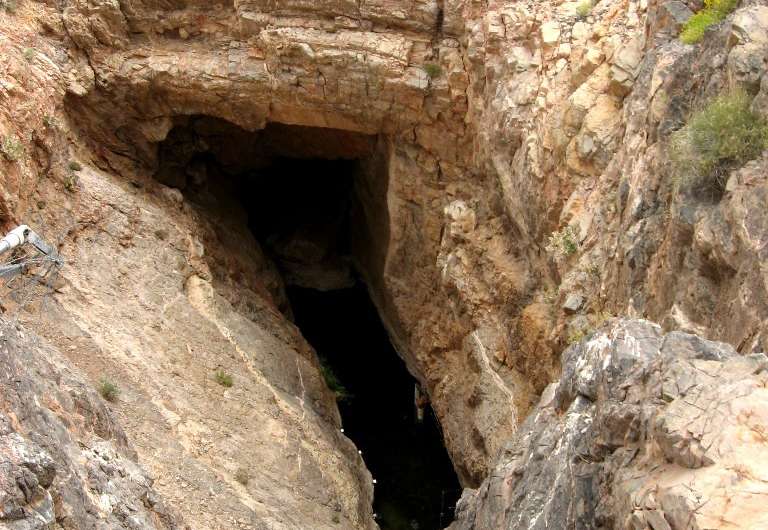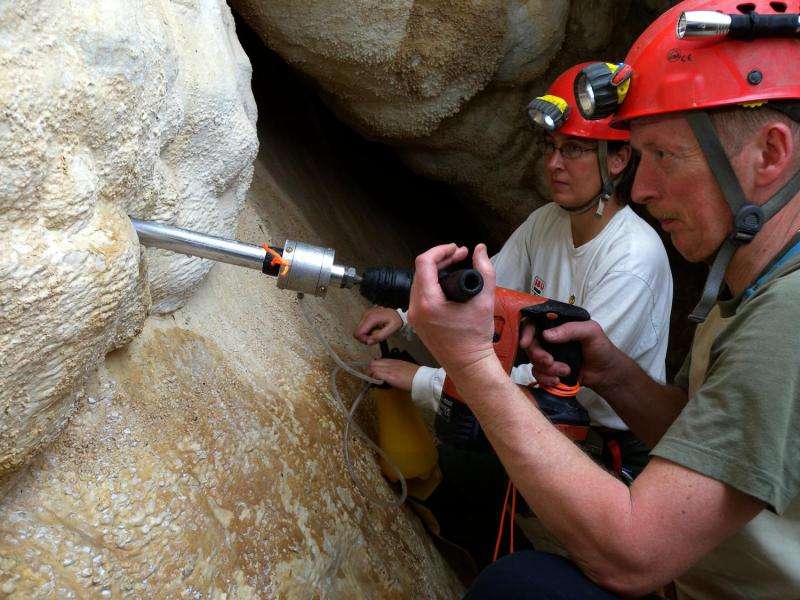Devils Hole in Nevada harbours up to 1 million years of climatological history. Credit: CC Ken Lund SA 2.0
Devils Hole in the U.S. is a unique place. In this subaqueous cavern, conditions have remained stable for hundreds of thousands of years. In a project supported by the Austrian Science Fund FWF, researchers from Innsbruck investigate this valuable climatological archive and, in the process, try to get to the bottom of a mystery.
Nevada, in the southwest U.S., is home to a unique location. Travellers through the Amargosa Desert at the edge of Death Valley can find a geological gem. A narrow crack in the rock allows a glimpse of a widespread underground water system. Devils Hole, as it is called, is a hotspot for paleoclimatologists. The mineral calcite precipitates in the warm water and deposits thick crusts on the walls of this cavern which is at least 150 metres deep. In the late 1980s, scientific investigations proved that these deposits offer complete and very precise climatological records of approximately the last 500,000 years.
Climatological data from 1 million years
In an FWF-funded project headed by the geologist Christoph Spötl from the University of Innsbruck, new measurements are being undertaken in the cavern with the aim of pushing the record back to 800,000 years and, possibly, beyond 1 million years. To get the data, the scientists sample calcite drill cores from above the groundwater table and use state-of-the-art measurement methods to determine their age. "The special thing about this place is the fact that the calcite crystallises extremely slowly and continuously, layer by layer," explains Spötl. "Like in a tree-trunk, only thousands of times longer." This distinguishes them from stalagmites, also coveted by researchers as "climate archives," which often stop growing after a few thousand to some dozens of thousands of years. Other factors, like magnetic signals, also help in recalculating the climate diary. "780,000 years ago was the last time the Earth's magnetic field turned by 180 degrees," notes Spötl. This pole change has been preserved in the deeper calcite layers of Devils Hole, as the scientists discovered in cooperation with the Leoben University of Mining Sciences. "This is supported by a first set of quite robust data," says Spötl.
Reconstruct climate change
Apart from conducting new measurements to date the calcite deposits, the researchers from Innsbruck also investigate the temperature of the water reservoir and fluctuations in the groundwater table. The lime deposits show, for instance, that the water table was significantly higher about 20,000 years ago – by approximately 9 metres. This enables the research team of Christoph Spötl to reconstruct dry and wet phases in this part of North America, and thus draw a clearer picture of climate history; an important historical record for the southwest U.S., which is currently plagued by droughts.
The big mystery
Researchers from Innsbruck sample calcite from drill cores taken from the cavern. Credit: Christoph Spötl, University Innsbruck
Moreover, the scientists would like to solve a big mystery around Devils Hole with their new investigation. Existing palaeoclimatological data from Nevada do not tally with data obtained elsewhere, for instance, from seabed deposits. This fact is still the subject of controversial discussions within the scientific community and an unresolved issue in climate research. "The controversy resides in the fact that the very big, global climate changes, like the transition from an ice age to a warm age, started significantly earlier here than anywhere else", explains Spötl. "We have come rather close to answering this question, which has been an issue for more than 20 years, but would not like to pre-empt publications currently in the pipeline."
Provided by Austrian Science Fund (FWF)

























